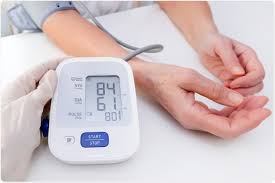
Hypotension is the medical term for low blood pressure. You have it when a reading shows your blood pressure is much lower than expected.
A blood pressure reading appears as two numbers. The top number is a measure of systolic pressure, or the pressure in the arteries when the heart beats and fills them with blood. The bottom number measures diastolic pressure, the pressure in the arteries when the heart rests between beats. The optimal blood pressure level is less than 120/80.
What is considered low blood pressure?
Doctors consider you to have low blood pressure when your reading is less than 90/60.
The risk of both low and high blood pressure increases with age due in part to normal changes during aging.
Is low blood pressure serious?
In healthy people, low blood pressure without any symptoms isn’t usually a concern and doesn’t require treatment. But low blood pressure can be a sign of an underlying problem — especially in older people — and could reduce blood flow to the heart, brain, and other vital organs.
Long-lasting low blood pressure with no symptoms is almost never serious. But you can have health problems when your blood pressure drops suddenly and your brain doesn’t have an adequate blood supply. This can lead to dizziness, lightheadedness, and sometimes fainting.
Recommended
There are several types of low blood pressure:
Postural hypotension
Sudden drops in blood pressure most often happen when you rise from a lying or sitting position to standing. This is called postural hypotension or orthostatic hypotension. It happens when your cardiovascular or nervous system doesn’t react appropriately to sudden position changes. An estimated 10% to 20% of people over 65 have postural hypotension.
Neurally mediated hypotension
You can get this type when you stand up for a long time. It’s thought to happen because of communication problems between your brain and your heart. It’s more common in younger people.
Postprandial hypotension
Sometimes, your blood pressure drops an hour or two after a meal. It’s thought to be caused by blood pooling into the vessels of the stomach and intestines. It’s most common in older people with high blood pressure or nervous system conditions like Parkinson’s disease. It tends to happen after large meals containing lots of carbohydrates.
Multiple system atrophy with orthostatic hypotension
This rare type of low blood pressure happens when you’re lying down. It involves your involuntary nervous system, which controls things like your blood pressure, breathing, and heart rate.
Low blood pressure (hypotension) has many causes. Often, it has no symptoms.
Causes of Low Blood Pressure
The cause of low blood pressure isn’t always clear. It may be linked to:
Pregnancy
Hormonal problems such as an underactive thyroid (hypothyroidism), diabetes, or low blood sugar (hypoglycemia)
Heart failure
Heart arrhythmias (abnormal heart rhythms)
Heart valve disease
Widening, or dilation, of the blood vessels
Heat exhaustion or heat stroke
Liver disease
Bed rest for long periods
Anemia caused by shortages of vitamin B12, iron, and folate
What Causes a Sudden Drop in Blood Pressure?
Sudden drops in blood pressure can be life-threatening. Causes of this type of hypotension include:
Loss of blood from bleeding
Low body temperature
High body temperature
Heart muscle disease causing heart failure
Sepsis, a severe blood infection
Severe dehydration from vomiting, diarrhea, or fever
A reaction to medication or alcohol
A severe allergic reaction called anaphylaxis that causes an irregular heartbeat
Postural Hypotension
Postural hypotension, which causes dizziness upon standing, can happen to anyone for a variety of reasons, such as dehydration, lack of food, or being overly fatigued. It can also be influenced by:
Your genes
Aging
Medication
your diet
Psychological factors
Conditions like infection and allergy
Postural hypotension happens most often in people who are taking drugs to control high blood pressure (hypertension). It can also be related to pregnancy, strong emotions, hardening of the arteries (atherosclerosis), or diabetes. Older people are particularly affected, especially those who have high blood pressure or autonomic nervous system dysfunction.
Several drugs are linked to postural hypotension. They can be divided into two main categories:
Drugs used to treat high blood pressure, such as diuretics, beta-blockers, calcium-channel blockers, and angiotensin-converting enzyme (ACE) inhibitors
Drugs that have hypotension as a side effect, including nitrates, erectile dysfunction (ED) medications, drugs for Parkinson’s disease, antipsychotics, neuroleptics, anti-anxiety agents, sedative-hypnotics, and tricyclic antidepressants
Common causes of naturally occurring postural hypotension include:
Dehydration and electrolyte loss, which may result from diarrhea, vomiting, excessive blood loss during your period, or other conditions
Age-related declines in blood pressure regulation, which may be made worse by certain health conditions or medications
Certain diseases can also cause postural hypotension. These include:
Nerve problems, such as peripheral neuropathy or autonomic neuropathy
Cardiovascular disorders
Alcoholism
Nutritional diseases
What Are the Symptoms of Low Blood Pressure?
Low blood pressure symptoms can include:
Dizziness
Lightheadedness
Unsteadiness
Dimming or blurring of vision
Agitation or other behavior changes
Weakness
Fatigue or lethargy
Confusion
Nausea
Cold, clammy skin
Fainting
Pale skin
If your blood pressure gets seriously low, your body might not get enough oxygen to carry out its normal functions. That can impair the functioning of your heart and brain and cause breathing problems. You could lose consciousness or go into shock (when the organs shut down). Shock symptoms may include:
Turning pale
Skin that feels cold
Fast breathing
Weak, quick pulse
Confusion
How Do I Know if I Have Low Blood Pressure?
Low blood pressure doesn’t always signal a problem. But if you have signs of low blood pressure, your doctor can diagnose the condition and uncover the cause. Then you can get the right treatment.
The doctor will look at your medical history, age, and symptoms, and do a physical exam. They may repeatedly check your blood pressure and pulse rate — after you’ve been lying down for a few minutes, right after you stand up, and within a few minutes after you stand quietly.
You might have other tests, such as an ECG (electrocardiogram) to measure heart rate and rhythm and an echocardiogram (an ultrasound test to visualize the heart). You may also have blood tests to look for anemia or problems with your blood sugar levels.
Your doctor might recommend more sophisticated home ECG monitoring (a Holter monitor or “event” monitor) to check for heart problems that come and go or an irregular heartbeat that can cause your blood pressure to drop suddenly.
An exercise stress test or, less commonly, an electrophysiology test (EP test) may also be helpful.
With some types of postural hypotension, you may need a “tilt table” test. It evaluates your body’s reaction to changes in position. You lie on a table, safely strapped in, and the table is raised to an upright position for up to an hour. Your blood pressure, heart rate, and symptoms are recorded. You might be given a drug that helps your doctor figure out what’s going on.
What Are the Treatments for Low Blood Pressure?
For many people, chronic low blood pressure can be effectively treated with diet and lifestyle changes. Others need medication to manage their symptoms.
Lifestyle changes to lower blood pressure
Depending on the cause of your symptoms, your doctor may tell you to increase your blood pressure by making these simple changes:
Eat a diet higher in salt.
Drink lots of nonalcoholic fluids.
Limit alcoholic beverages.
Drink more fluids during hot weather and while sick with a viral illness, such as a cold or the flu.
Have your doctor check your prescription and over-the-counter medications to see if any of them are causing your symptoms.
Get regular exercise to promote blood flow.
Be careful when rising from lying down or sitting. To improve circulation, pump your feet and ankles a few times before standing up. Then go slowly. When you get out of bed, sit upright on the edge of the bed for a few minutes before standing.
Raise the head of your bed at night by placing bricks or blocks under it.
Avoid heavy lifting.
Avoid straining while on the toilet.
Avoid standing still for long periods.
Avoid prolonged exposure to hot water, such as hot showers and spas. If you get dizzy, sit down. It may help to keep a chair or stool in the shower in case you need to sit. To prevent injury, use a nonslip chair or stool designed for use in showers and bath tubs.
To avoid problems with low blood pressure and lessen episodes of dizziness after meals, try eating smaller, more frequent meals. Cut back on carbohydrates. Rest after eating. Avoid taking drugs to lower blood pressure before meals.
If needed, use elastic support (compression) stockings that cover the calf and thigh. These help restrict blood flow to your legs, thus keeping more blood in your upper body.
Medications for low blood pressure
If these steps don’t lessen the problem, you may need medication. These drugs are sometimes used to treat low blood pressure:
Fludrocortisone. This medication seems to help some types of low blood pressure. It works by promoting sodium retention by your kidneys. This causes fluid retention and some swelling, which is necessary to improve blood pressure. But sodium retention also causes a loss of potassium. So when taking fludrocortisone, make sure you get enough potassium each day. Fludrocortisone has none of the anti-inflammatory properties of cortisone or prednisone and doesn’t build muscle like anabolic steroids.
Midodrine. This drug activates receptors on your smallest arteries and veins to boost blood pressure. It’s used to increase standing blood pressure in people who have postural hypotension related to problems with the nervous system.
Complications of Low Blood Pressure
Complications you could develop because of low blood pressure include:
Falls
Dizziness caused by low blood pressure can make you fall or faint. Falls can result in injuries, sometimes serious ones.
Heart problems or stroke: Your heart might try to make up for low blood pressure by pumping too hard or too fast. That can lead to problems like heart failure, stroke, or deep vein thrombosis (DVT).
Shock
Seriously low blood pressure can limit blood supply to your organs so much that you go into shock. If you have symptoms of shock, call emergency number
Low blood pressure during pregnancy can lead to an increased risk of falls. But there’s no scientific evidence that low blood pressure by itself is harmful to your baby unless it gets low enough to send you into shock
When to Call a Doctor
Call your Doctor if:
You have any of the symptoms listed above.
You’ve been diagnosed with low blood pressure and are more often having symptoms, such as falling down or passing out.
You have symptoms as a result of taking prescription or nonprescription medication.
Takeaways
Low blood pressure often has no symptoms and doesn’t require treatment. But seriously low blood pressure can lead to complications. See your doctor if you have low blood pressure symptoms.
What are the reasons for low blood pressure?
Many different things can cause low blood pressure, including:
Dehydration
Pregnancy
Fear, stress, or pain
Donating blood
Heat
Some injuries and illnesses
Certain medications
© WebMD
For Advert, Event Coverage, Story/Article Publication, Change Of Name & Placement In Newspapers, PR & Other Media Services
Contact Us On: WhatsApp
Send Email To: citizennewsng@gmail.com
Visit Citizen NewsNG To Read More Latest And Interesting News













